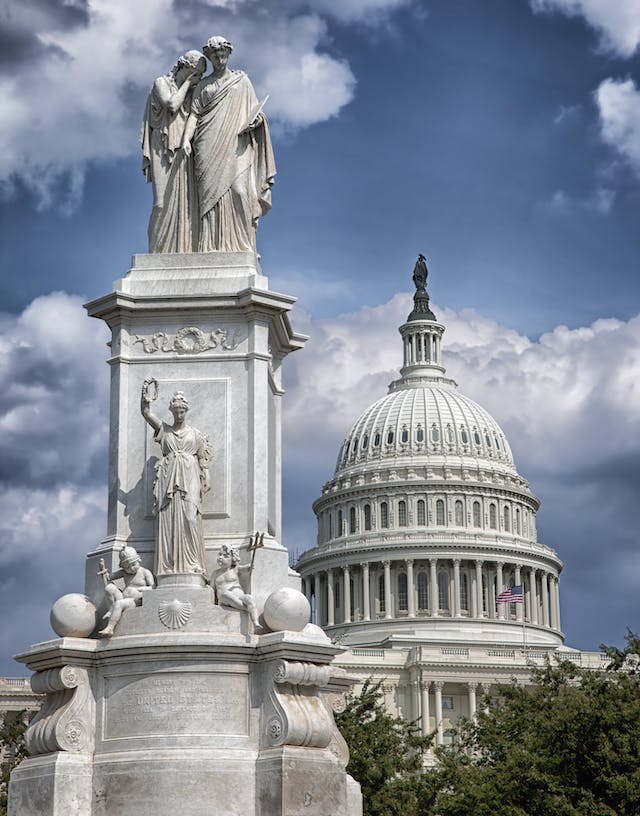The United States Capitol in Washington, DC is one of the most recognizable buildings in the country, serving as a symbol of the United States Congress and the legislative branch. The House of Representatives and Senate meet, debate, and discuss national legislation in the Capitol Building.
President George Washington selected and awarded the design for the Capitol to William Thornton in 1793. On September 18, 1793, Washington laid the cornerstone of the Capitol on what was then known as Jenkins Hill. Initially, the Library of Congress was housed in this structure, but it was eventually moved to a larger building close to the Capitol, where it remains today. Over the last 200 years, the Capitol has been enlarged and expanded several times.
Architectural Style on Capitol Hill

The prevailing architectural style on Capitol Hill is neoclassical, which was inspired by the use of ancient Greek and Roman designs for grand public buildings. Tall columns, symmetrical shapes, triangular pediments, and domed roofs distinguish these styles.
The Neoclassical architectural style incorporates the Federal and Greek Revival architectural styles that were popular in the late 18th and early 19th centuries. Many of the foundational buildings of the United States government were built during this time period.
The United States Capitol Building is perhaps the best example of these architectural styles. The designs of the United States Capitol, inspired by ancient Greece and Rome, evoke the ideals that guided the nation’s founders as they framed their new republic. Architect Thomas U. Walter expanded on the original design while maintaining the neoclassical styles in the 1850s. The north and south extensions, as well as the cast iron dome, were all added by him.
Columns of the U.S. Capitol
The National Capitol Columns are one of Washington’s most notable and unusual landmarks. The stately permanence of the Corinthian columns, as well as their careful placement on a natural knoll in the Ellipse Meadow, give the impression that they have been there for a very long time.
In 1828, these columns were installed in the Capitol Building’s East Portico. They were barged to Washington in the early days of our country, before the familiar Capitol dome was completed, from sandstone near Aquia Creek in Virginia. Their time at the Capitol, however, was to be limited due to an oversight. Because the iron dome that was eventually built was significantly larger than the one that the designer had envisioned, the Capitol dome, completed in 1864, appeared to be inadequately supported by the columns. To eliminate this unsettling illusion, an addition to the east side of the Capitol was proposed, but it was not built until 1958. More time would pass before the columns arrived at the National Arboretum for their final resting place.
The Hall of Columns is a dramatic, high-ceilinged corridor that runs directly beneath the Hall of Representatives. The capitals in the Hall of Columns are a variation on the Corinthian order, with thistles and native American tobacco plants in addition to classical acanthus leaves. Benjamin Henry Latrobe’s corncob capitals in a first-floor vestibule and his tobacco-leaf capitals in the small Senate rotunda are examples of earlier uses of American vegetation in the building’s capitals. The hall was built in the mid-nineteenth century as part of architect Thomas U. Walter’s Capitol extension, which included the current House and Senate wings as well as the dome. The columns’ marble was quarried in Lee, Massachusetts. According to Walter’s annual report, by October 1855, roughly half of the columns and pilasters had been installed, and the carving of the capitals had begun. By November 1856, all of the columns had been installed, as had the entablature and cast-iron ceiling. Hayward, Bartlett, and Co. foundry in Baltimore cast the ceiling.
Column Count in the Capitol Building
The National Capitol Columns are a monument in the National Arboretum in Washington, D.C. The Ellipse Meadow is a 20-acre (8.1-hectare) open meadow including a cluster of twenty-two Corinthian columns that were part of the Capitol from 1828 to 1958.
The columns were carved from sandstone near Aquia Creek in Virginia and transported by barge to Washington. Some of the stones still have quarry identification marks visible. They were originally built in 1828 as part of the Capitol’s east portico, long before the familiar Capitol dome was completed. However, when the dome was finished in 1866, the columns appeared to be inadequately supporting it because the iron dome was significantly larger than the dome that the designer envisioned. To correct this optical illusion, an addition to the Capitol’s east side was built in 1958, and the columns were removed.
During the 1980s, Arboretum benefactor Ethel Garrett spearheaded the effort to find a permanent home for the columns. Russell Page, a landscape designer and close friend of Garrett’s, visited the Arboretum just months before his death in September 1984. He determined that the east side of the Ellipse Meadow would be an ideal location because the columns would be in scale with the site’s more than 20 acres (8.1 ha) of open meadow.
The columns were moved to this location and set on a foundation of stones from the steps on the Capitol’s east side. A reflecting pool, fed by a small rivulet of water running down the steps, reflects the columns while also providing sound and movement.
A capital, or top portion, of one of the columns is located elsewhere in the meadow so that visitors can see the detail incorporated into the design by the stone carver. Acanthus leaves are clearly visible, as are the many layers of paint that were applied while the column was in place at the Capitol.
The East Front center portico and the West Front contain examples of a modified Corinthian column style on the Capitol Building’s exterior. There are 28 fluted, white marble columns that line the Hall of Columns, which is located on the first floor of the Capitol’s House Wing.

